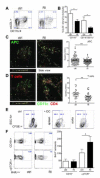Increased atherosclerotic lesion formation and vascular leukocyte accumulation in renal impairment are mediated by interleukin-17A
- PMID: 23908345
- PMCID: PMC3848055
- DOI: 10.1161/CIRCRESAHA.113.301934
Increased atherosclerotic lesion formation and vascular leukocyte accumulation in renal impairment are mediated by interleukin-17A
Abstract
Rationale: Atherosclerosis is a major cause of death in patients with chronic kidney disease. Chronic inflammation of the arterial wall including invasion, proliferation, and differentiation of leukocytes is important in atherosclerotic lesion development. How atherosclerotic inflammation is altered in renal impairment is incompletely understood.
Objective: This study analyzed leukocytes of the atherosclerotic aorta in mice with impaired and normal renal function and studied a mechanism for the alteration in aortic myeloid leukocytes.
Methods and results: Unilateral nephrectomy significantly decreased glomerular filtration rate and increased atherosclerotic lesion size and aortic leukocyte numbers in 2 murine atherosclerosis models, apolipoprotein E (Apoe(-/-)) and low-density lipoprotein (LDL) receptor-deficient (LDLr(-/-)) mice. The number of aortic myeloid cells increased significantly. They took-up less oxidized LDL, whereas CD11c expression, interaction with T cells, and aortic T cell proliferation were significantly enhanced in renal impairment. In human peripheral blood mononuclear cell cultures, chronic kidney disease serum decreased lipid uptake and increased human leukocyte antigen II (HLA II) expression. Supplementation with interleukin-17A similarly increased HLA II and CD11c expression and impaired oxidized LDL uptake. Interleukin-17A expression was increased in atherosclerotic mice with renal impairment. Ablation of interleukin-17A in LDLr(-/-) mice by lethal irradiation and reconstitution with Il17a(-/-) bone marrow abolished the effect of renal impairment on aortic CD11b(+) myeloid cell accumulation, CD11c expression, and cell proliferation. Atherosclerotic lesion size was decreased to levels observed in normal kidney function.
Conclusions: Kidney function modifies arterial myeloid cell accumulation and phenotype in atherosclerosis. Our results suggest a central role for interleukin-17A in aggravation of vascular inflammation and atherosclerosis in renal impairment.
Keywords: atherosclerosis; interleukin-17; leukocytes; renal insufficiency; vascular inflammation.
Figures







Similar articles
-
Smooth Muscle Cell-Derived Interleukin-17C Plays an Atherogenic Role via the Recruitment of Proinflammatory Interleukin-17A+ T Cells to the Aorta.Arterioscler Thromb Vasc Biol. 2016 Aug;36(8):1496-506. doi: 10.1161/ATVBAHA.116.307892. Epub 2016 Jun 30. Arterioscler Thromb Vasc Biol. 2016. PMID: 27365405 Free PMC article.
-
Atypical chemokine receptor 1 deficiency reduces atherogenesis in ApoE-knockout mice.Cardiovasc Res. 2015 Jun 1;106(3):478-87. doi: 10.1093/cvr/cvv124. Epub 2015 Apr 8. Cardiovasc Res. 2015. PMID: 25858253 Free PMC article.
-
Deficiency of HIF1α in Antigen-Presenting Cells Aggravates Atherosclerosis and Type 1 T-Helper Cell Responses in Mice.Arterioscler Thromb Vasc Biol. 2015 Nov;35(11):2316-25. doi: 10.1161/ATVBAHA.115.306171. Epub 2015 Sep 24. Arterioscler Thromb Vasc Biol. 2015. PMID: 26404487 Free PMC article.
-
Interleukin 17A in atherosclerosis - Regulation and pathophysiologic effector function.Cytokine. 2019 Oct;122:154089. doi: 10.1016/j.cyto.2017.06.016. Epub 2017 Jun 26. Cytokine. 2019. PMID: 28663097 Review.
-
Meta-Analysis of Leukocyte Diversity in Atherosclerotic Mouse Aortas.Circ Res. 2020 Jul 17;127(3):402-426. doi: 10.1161/CIRCRESAHA.120.316903. Epub 2020 Jul 16. Circ Res. 2020. PMID: 32673538 Free PMC article. Review.
Cited by
-
Aggravated Atherosclerosis and Vascular Inflammation With Reduced Kidney Function Depend on Interleukin-17 Receptor A and Are Normalized by Inhibition of Interleukin-17A.JACC Basic Transl Sci. 2018 Jan 10;3(1):54-66. doi: 10.1016/j.jacbts.2017.08.005. eCollection 2018 Feb. JACC Basic Transl Sci. 2018. PMID: 30062194 Free PMC article.
-
A Critical Role of PCSK9 in Mediating IL-17-Producing T Cell Responses in Hyperlipidemia.Immune Netw. 2019 Dec 4;19(6):e41. doi: 10.4110/in.2019.19.e41. eCollection 2019 Dec. Immune Netw. 2019. PMID: 31921471 Free PMC article.
-
A Randomized Placebo-Controlled Trial of Secukinumab on Aortic Vascular Inflammation in Moderate-to-Severe Plaque Psoriasis (VIP-S).J Invest Dermatol. 2020 Sep;140(9):1784-1793.e2. doi: 10.1016/j.jid.2020.01.025. Epub 2020 Feb 21. J Invest Dermatol. 2020. PMID: 32088207 Free PMC article. Clinical Trial.
-
Upregulation of OLR1 and IL17A genes and their association with blood glucose and lipid levels in femoropopliteal artery disease.Exp Ther Med. 2017 Mar;13(3):1160-1168. doi: 10.3892/etm.2017.4081. Epub 2017 Jan 24. Exp Ther Med. 2017. PMID: 28450958 Free PMC article.
-
Extracellular vesicles as mediators of vascular inflammation in kidney disease.World J Nephrol. 2016 Mar 6;5(2):125-38. doi: 10.5527/wjn.v5.i2.125. World J Nephrol. 2016. PMID: 26981436 Free PMC article. Review.
References
-
- Tonelli M, Wiebe N, Culleton B, House A, Rabbat C, Fok M, McAlister F, Garg AX. Chronic kidney disease and mortality risk: A systematic review. Journal of the American Society of Nephrology : JASN. 2006;17:2034–2047. - PubMed
-
- Astor BC, Hallan SI, Miller ER, 3rd, Yeung E, Coresh J. Glomerular filtration rate, albuminuria, and risk of cardiovascular and all-cause mortality in the us population. American journal of epidemiology. 2008;167:1226–1234. - PubMed
-
- Go AS, Chertow GM, Fan D, McCulloch CE, Hsu CY. Chronic kidney disease and the risks of death, cardiovascular events, and hospitalization. The New England journal of medicine. 2004;351:1296–1305. - PubMed
-
- Herzog CA, Asinger RW, Berger AK, Charytan DM, Diez J, Hart RG, Eckardt KU, Kasiske BL, McCullough PA, Passman RS, DeLoach SS, Pun PH, Ritz E. Cardiovascular disease in chronic kidney disease. A clinical update from kidney disease: Improving global outcomes (kdigo) Kidney Int. 2011;80:572–586. - PubMed
-
- Schiffrin EL, Lipman ML, Mann JF. Chronic kidney disease: Effects on the cardiovascular system. Circulation. 2007;116:85–97. - PubMed
Publication types
MeSH terms
Substances
Grants and funding
LinkOut - more resources
Full Text Sources
Other Literature Sources
Medical
Molecular Biology Databases
Research Materials
Miscellaneous

